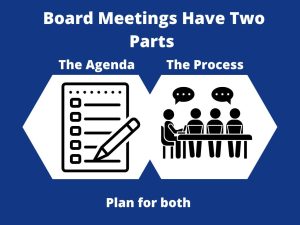
Optimize Your Nonprofit Board Meetings: Make Them Effective & Efficient
Board meetings take time and resources. You recruit, update, prepare, attend, and follow up. Your board members devote half a day per meeting, including prep and travel.
Here’s how to make these meetings engaging and worthy of the investment:
1. Perfect the Time Frame
Plan meetings for 90 minutes or less to keep energy high and inspire focus.
2. Limit Decisions
Target three quality decisions per meeting. Focus on what’s most critical in this meeting. Adopt this exercise to help organize priorities.
3. Streamline the Agenda
Organize items logically and label them with the desired outcome. For example, “Decide next step to open new location” instead of “Discuss new site.”
4. List Time Expectations
Add time estimates to the agenda. Estimates show priorities and help manage discussions. It guides the verbose.
5. Keep the End Goal in Mind
Before you finalize the agenda, evaluate your time investments. Plan to invest more time in discussions that have a more significant impact. Briefly discuss smaller items.
6. Plan Your Approach
Frame each topic clearly. Prepare questions and anticipate board queries.
All meetings have two parts: the agenda and the process. Plan for each. Most people focus on the agenda—getting things done. The process builds relationships and improves decision quality.
7. Build Relationships
Include a brief one-on-one or group exercise. Five-minute directed conversations build relationships and enhance group discussions. It’s an investment in future issues.
8. Avoid Micromanaging
Ensure agenda items are strategic, not management-focused. Adjust questions to reflect this. It’s one thing to have the board try to micromanage; it is another to invite it. Watch How to Help Your Nonprofit Board Stay in the Governance Lane.
9. Handle Other Items Efficiently
10. End Strong
You have options. End with peer shout-outs. And, or do a quick meeting evaluation. Endings matter, and the power of leaving on a positive note can elevate the entire board meeting experience.
Maximize Board Impact:
Print this list and keep it in your board agenda file.
For more guidance, check out this Nonprofit CEO Library and sign up for KKaren’sCEO Solutions for solutions delivered to your inbox.
Karen Eber Davis is a nonprofit strategic planning consultant who works with visionary leaders committed to taking their organizations to new heights. She offers customized strategies, assessments, and coaching designed to help leaders lead their organizations to achieve their potential. She is the author of 7 Nonprofit Income Streams and Let's Raise Nonprofit Millions Together.
Categories
If you appreciate these Added Value posts, please consider subscribing.
Latest Posts
- How New Nonprofit CEOs Secure Board Buy-In for Strategic Planning
- How Nonprofit Leader Navigate Crisis with Clarity & Confidence
- One Way AI Can Help You Find a Path Where None Exists
- In Crisis? Resist Cutting Your Ability to Make Income
- Nonprofit Strategic Planning Assessment: 10 Questions to Strengthen Your Strategy
